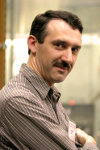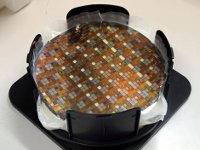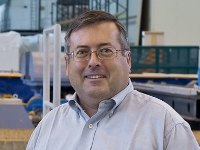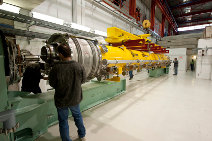From SLAC today: People: Andrei Seryi

Andrei Seryi. (Photo by Diana Rogers.)
|
Since beginning his career in 1986, SLAC senior scientist and project manager for FACET Andrei Seryi has worked at five labs in three countries, with the last 10 years at SLAC. In this decade, Seryi has led international collaborations to design and build linear accelerator experimental facilities, all while continuing his accelerator research and design projects at SLAC.
Today, Seryi devotes most of his efforts at SLAC to the FACET project—Facilities for Accelerator Science and Experimental Test Beams at SLAC—an experimental facility created for studies of advanced methods of plasma wakefield acceleration of electron and positron beams.
Read more...
-- Lauren Knoche |
 |
|
|
 |
Upcoming meetings, conferences, workshops
CLIC09 Workshop
CERN
12-16 October 2009
12th International Conference On Accelerator And Large Experimental Physics Control Systems (ICALEPCS 2009)
Kobe International Conference Center, Kobe, Japan
12-16 October 2009
EUDET Annual Meeting
University of Geneva and CERN, Geneva, Switzerland
19-21 October 2009
FCAL Collaboration Meeting
CERN, Geneva, Switzerland
21-22 October 2009
2009 IEEE Nuclear Science Symposium and Medical Imaging Conference
Orlando, Florida, USA
25-31 October 2009
6th ILC Positron Source Collaboration Meeting
IPPP, Durham, UK
28-30 October 2009
|
|
|
GDE Meetings calendar
View complete ILC calendar
|
|
|
 |
SOI technology for next-generation sensors

Prototype of monolithic pixel detector at KEK |
What do you visualise when you are asked about a sensor? There are many sensors around us. For example, CCDs (Charge Coupled Device), which is the basis of today’s digital camera, and the technology for this year's Nobel Prize in Physics are also sensors. Thus, sensors are absolutely necessary devices for our daily life and also important technologies for the International Liner Collider. In the last years, many new sensors have been developed for the ILC, one of them being pixel sensors using Silicon-On-Insulator (SOI) technology for particle detectors, under development at KEK’s Detector Technology Project Office. This sensor is expected to serve as one of the alternatives for particle sensors used in such parts as the silicon vertex detector.
Read more...
-- Hajime Tanaka |
 |
|
|
 |
From European XFEL
13 October 2009
HRB 111165: The European XFEL GmbH has been founded!
“Now it’s official and we’re legally authorized to operate” Massimo Altarelli and Karl Witte rejoiced on taking up their new functions as Managing Directors of the European XFEL GmbH.
Read more... |
|
From nature blogs
12 October 2009
UK Press + CERN arrests + al-Qaeda = Cold fusion?
... But wait? Did we hear the word "nuclear" and "al-Qaeda"? Cue the press. Coverage has been wide and varied, but for the best of the best, you have to the UK:
Read more... |
|
From interactions.org
9 October 2009
UK Accelerator Research Receives a Boost
Research into accelerator science and technology in the UK has received a boost with the announcement of nearly £20m of funding by the Science and Technology Facilities Council (STFC) to The Cockcroft and John Adams Institutes.
Read more... |
|
From Science
9 October 2009
Russian Expats Challenge Country's Support of Science
... In their letter, they suggested the country try to attract world-scale scientific projects, using as a concrete example the construction of the International Linear Collider. This high-energy particle collider, envisioned as a possible successor to the Large Hadron Collider, would boost Russia’s research in many fields, including information science, biology, and materials science, they say.
Read more... |
|
|
 |
 |
|
|
 |
CERN prepares for LHC commissioning

Philippe Lebrun, CERN |
Once again, the Large Hadron Collider at CERN is moving to centre stage. The LHC is the world's largest and highest-energy particle accelerator designed to collide protons at energies of 7 TeV per beam. Just about one year ago, as commissioning of this complex next-generation machine was being initiated, the immediate success of circulating beam in the main ring of the LHC for the first time was interrupted by a serious fault between two superconducting magnets. The past year has been dedicated to carrying out the time consuming repairs and provisions to prevent future such incidents. Those repairs are nearing completion and commissioning is set to resume in mid-November. We were very fortunate to hear a timely report from Philippe Lebrun on the status of the LHC and plans for commissioning at the American Linear Collider Physics Group workshop (ALCPG09) in Albuquerque at the end of September.
Read more...
-- Barry Barish
Director's Corner Archive |
 |
|
|
 |
RF Unit Test Facility takes (big and yellow) shape

Fermilab engineers and technicians move the first ILC-like cryomodule assembled at the laboratory into place to for testing. It will become the front-end of Fermilab's future accelerator R&D test beam in the SRF Test Facility.
Photo courtesy of Fermilab.
|
|
arXiv preprints
0910.2235
A Finely-Predicted Higgs Boson Mass from A Finely-Tuned Weak Scale
0910.2106
Supersymmetry and other New Physics at gamma gamma colliders
0910.1305
High-gradient SRF Cavity with Minimized Surface E.M. Fields and Superior Bandwidth for the ILC
|
|

